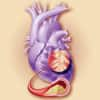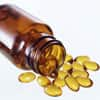
What's Hot
What's Hot
News flashes are posted here frequently to keep you up-to-date with the latest advances in health and longevity. We have an unparalleled track record of breaking stories about life extension advances.
- Coenzyme Q10 improves heart failure survival during two year trial
- Fish oil supplementation could lower harmful stress response
- Phosphatidylserine holds promise for brain disorders
- Ginger shows promise for asthma
- Vitamin D may protect against the development of uterine fibroids
- Study results indicate safety of antioxidants following breast cancer therapy
- Greater fiber intake linked with lower risk of kidney cancer
- Greater fat intake results in reduced daytime alertness
- Meta-analysis concludes selenium may reduce mortality in sepsis
- Vitamin C consumed by pregnant smokers may help prevent respiratory problems in infants
- Mediterranean diet linked with lower risk of developing dementia
- Reduced vitamin D levels linked to pneumonia
Coenzyme Q10 improves heart failure survival during two year trial
 May 31, 2013. On May 25, 2013 at the Heart Failure Association of the European Society of Cardiology’s annual meeting, Professor Svend Aage Mortensen of Copenhagen University Hospital reported a significant reduction in mortality among heart failure patients supplemented with coenzyme Q10 (CoQ10) over a two year period.
May 31, 2013. On May 25, 2013 at the Heart Failure Association of the European Society of Cardiology’s annual meeting, Professor Svend Aage Mortensen of Copenhagen University Hospital reported a significant reduction in mortality among heart failure patients supplemented with coenzyme Q10 (CoQ10) over a two year period.
The Q-SYMBIO study included 420 participants being treated for Class III or IV heart failure as classified by the New York Heart Association. Subjects were randomized to receive 100 milligrams CoQ10 or a placebo three times daily for two years.
At the trial’s conclusion, 14% of those who received CoQ10 and 25% of the placebo group experienced a first major adverse cardiovascular event, which included hospitalization due to heart failure, cardiovascular death, urgent heart transplantation or mechanical circulatory support. In addition, the risk of dying of any cause over the course of the trial was twice as great among the placebo group in comparison to those that received CoQ10.
"CoQ10 is the first medication to improve survival in chronic heart failure since ACE inhibitors and beta blockers more than a decade ago and should be added to standard heart failure therapy," Dr Mortensen stated. "Other heart failure medications block rather than enhance cellular processes and may have side effects. Supplementation with CoQ10, which is a natural and safe substance, corrects a deficiency in the body and blocks the vicious metabolic cycle in chronic heart failure called the energy starved heart."
Because statin drugs used for ischemic heart disease lower CoQ10, patients with this condition could also benefit from CoQ10. “We have no controlled trials demonstrating that statin therapy plus CoQ10 improves mortality more than statins alone,” Dr Mortensen noted. “But statins reduce CoQ10, and circulating CoQ10 prevents the oxidation of LDL effectively, so I think ischemic patients should supplement statin therapy with CoQ10."
—D Dye
Fish oil supplementation could lower harmful stress response
 May 24, 2013. The April 1, 2013 issue of the American Journal of Physiology – Regulatory, Integrative, and Comparative Physiology published the results of a double-blinded trial which found a reduction in the adverse reaction to mental stress in men and women given fish oil.
May 24, 2013. The April 1, 2013 issue of the American Journal of Physiology – Regulatory, Integrative, and Comparative Physiology published the results of a double-blinded trial which found a reduction in the adverse reaction to mental stress in men and women given fish oil.
“Despite the well-documented link between mental stress and cardiovascular risk, no study has examined neural cardiovascular reactivity to mental stress after fish oil supplementation,” authors Jason R. Carter of Michigan Technological University and his coauthors note in their introduction.
The study included 67 nonhypertensive men and women whose age averaged 24 years. The participants were divided to receive 9 grams fish oil or 9 grams olive oil daily for eight weeks. Before and after the treatment period, the subjects underwent assessment of resting heart rate, blood pressure, muscle sympathetic nerve activity, and forearm and calf blood flow, followed by reassessment during a situation created to induce mental stress.
While resting assessments did not differ significantly between the groups by the end of the study, those who received fish oil experienced reductions in heart rate reactivity and total muscle sympathetic nerve activity in response to stress in comparison with the olive oil group. The finding suggests that fish oil could help protect the cardiovascular system during stress, and may be one of several reasons why it helps maintain heart health.
"Overall, the data support and extend the growing evidence that fish oil may have positive health benefits regarding neural cardiovascular control in humans and suggest important physiological interactions between fish oil and psychological stress that may contribute to disease etiology,” the authors conclude. “Future studies might examine the influence of longer duration (i.e., chronic) fish oil supplementation on neural cardiovascular reactivity to mental stress, with a particular focus on aged and/or diseased populations.”
—D Dye
Phosphatidylserine holds promise for brain disorders
 May 22, 2013. In an article published online on March 20, 2013 in the journal Human Molecular Genetics, researchers at Tel Aviv University report that phosphatidylserine, a compound occurring in soy and other foods, could be of benefit to individuals with familial dysautomnia, a disorder that occurs in Ashkenazi Jewish men and women. Familial dysautomnia is caused by a mutation that results in the inhibition of the manufacture of IκB kinase complex-associated protein (IKAP) which is believed to be involved in genetic transcription.
May 22, 2013. In an article published online on March 20, 2013 in the journal Human Molecular Genetics, researchers at Tel Aviv University report that phosphatidylserine, a compound occurring in soy and other foods, could be of benefit to individuals with familial dysautomnia, a disorder that occurs in Ashkenazi Jewish men and women. Familial dysautomnia is caused by a mutation that results in the inhibition of the manufacture of IκB kinase complex-associated protein (IKAP) which is believed to be involved in genetic transcription.
Gil Ast and colleagues administered phosphatidylserine to cells derived from familial dysautomnia patients and observed an increase in gene function as well as higher levels of IKAP. The team then fed the supplement every two days for three months to mice genetically engineered with the mutation that causes the disease in humans. “We found a significant increase of the protein in all the tissues of the body, including an eight-fold increase in the liver and 1.5-fold increase in the brain," reported Dr Ast, who is a professor in Tel Aviv University’s Department of Human Molecular Genetics and Biochemistry. "While the food supplement does not manufacture new nerve cells, it probably delays the death of existing ones.”
"That we see such an effect on the brain — the most important organ in relation to this disease — shows that the supplement can pass through the blood-brain barrier even when administered orally, and accumulate in sufficient amounts in the brain,” he added.
In addition to the gene associated with familial dysautomnia, the team observed alterations in other 2,400 other genes, many of which have been associated with Parkinson’s disease, in association with the administration of phosphatidylserine. The finding suggests that phosphatidylserine could be helpful for other neurodegenerative disorders.
—D Dye
Ginger shows promise for asthma
 May 20, 2013. The American Thoracic Society’s 2013 International Conference, held May 17 to 22 in Philadelphia, was the site of a presentation concerning the ability of compounds that occur in ginger to relax airway smooth muscle tissue, which is constricted during asthma attacks.
May 20, 2013. The American Thoracic Society’s 2013 International Conference, held May 17 to 22 in Philadelphia, was the site of a presentation concerning the ability of compounds that occur in ginger to relax airway smooth muscle tissue, which is constricted during asthma attacks.
Elizabeth Townsend, PhD of Columbia University and her colleagues studied the effects of 6-gingerol, 8-gingerol and 6-shogoal in human airway smooth muscle tissue samples treated with acetylcholine, a neurotransmitter that causes bronchoconstriction. The compounds or a control substance were combined and administered with the beta-agonist bronchodilator drug isoproterenol.
Combining the drug with ginger compounds resulted in greater airway tissue relaxation than administering the drug alone. The ginger compound 6-shogoal elicited the strongest effect. The researchers determined that the compounds help inhibit phosphodiesterase 4D (PDE4D, an enzyme that negatively impacts processes involved in the relaxation of airway smooth muscle tissue). Additionally, 6-shogaol was found to dissolve F-active filaments that are involved in bronchoconstriction.
"Asthma has become more prevalent in recent years, but despite an improved understanding of what causes asthma and how it develops, during the past 40 years few new treatment agents have been approved for targeting asthma symptoms," noted Dr Townsend, who is a post-doctoral research fellow at Columbia University’s Department of Anesthesiology. "In our study, we demonstrated that purified components of ginger can work synergistically with beta-agonists to relax airway smooth muscle."
"Taken together, these data show that ginger constituents 6-gingerol, 8-gingerol and 6-shogaol act synergistically with the beta-agonist in relaxing airway smooth muscle, indicating that these compounds may provide additional relief of asthma symptoms when used in combination with beta-agonists," she added. "By understanding the mechanisms by which these ginger compounds affect the airway, we can explore the use of these therapeutics in alleviating asthma symptoms."
—D Dye
Vitamin D may protect against the development of uterine fibroids
 May 17, 2013. The May, 2013 issue of the journal Epidemiology published an article which reports the finding of vitamin D researcher Bruce W. Hollis and his colleagues of a lower risk of uterine fibroid tumors in women with sufficient levels of vitamin D.
May 17, 2013. The May, 2013 issue of the journal Epidemiology published an article which reports the finding of vitamin D researcher Bruce W. Hollis and his colleagues of a lower risk of uterine fibroid tumors in women with sufficient levels of vitamin D.
The study evaluated 620 African American and 416 Caucasian women between the ages of 35 to 49 who were enrolled in the National Institute of Environmental Health Sciences Uterine Fibroid Study. Serum 25-hydroxyvitamin D levels were measured in blood samples collected upon enrollment and ultrasound examinations ascertained the presence and size of fibroids.
Insufficient vitamin D levels were found in 90 percent of African American and 50 percent of Caucasian participants. Subjects with sufficient serum levels of the vitamin, which the researchers classified as 20 nanograms per milliliter (ng/mL) or higher, had a 32 percent lower risk of having fibroids in comparison with those whose levels were sufficient. Each 10 ng/mL increase in vitamin D was associated with a 20 percent reduction in fibroid risk. The reduction in risk was similar for small and large fibroids, and for African Americans and Caucasians. Sun exposure of at least an hour per day was also associated with a lower risk of the condition.
The authors remark that treatment of cultures of human uterine fibroid tissue with a form of vitamin D results in decreased cell proliferation accompanied by inhibition of molecular pathways for fibrosis. They conclude that the current findings provide evidence for a causal relationship between sufficient vitamin D and protection against fibroids that warrants further investigation.
—D Dye
Study results indicate safety of antioxidants following breast cancer therapy
 May 15, 2013. An article published on May 19, 2013 in Breast Cancer Research and Treatment reports that supplementation with antioxidants after treatment for breast cancer is not only safe but may help improve survival.
May 15, 2013. An article published on May 19, 2013 in Breast Cancer Research and Treatment reports that supplementation with antioxidants after treatment for breast cancer is not only safe but may help improve survival.
Elizabeth M. Poole of Harvard University and her associates analyzed data from 12,019 breast cancer survivors enrolled in one of four studies included in the After Breast Cancer Pooling Project. The analysis examined the use of supplements at least one year after diagnosis. Over follow-up, 1,298 deaths occurred, of which 65 percent were due to breast cancer.
Sixty percent of the women reported using supplements from one to five years following diagnosis. The use of any antioxidant supplement, categorized as vitamins C, E or a multivitamin supplement in this study, was associated with a 16% lower adjusted risk of dying from any cause over follow-up, and for those who used all three supplements, the risk was 21% lower. Supplementation with vitamin C was associated with a 19% lower risk of death and a 10% reduction in the risk of breast cancer occurrence, and for vitamin E, the risk of dying of any cause was lowered by 15% and of recurrence by 12%, however; these associations were reduced after adjustment for other antioxidant use. The risk of recurrence was 36% lower in association with the use of vitamin D among women with estrogen receptor-positive tumors.
"In this large consortium of breast cancer survivors, post-treatment use of vitamin supplements was not associated with increased risk of recurrence or death," the authors write. "Post-treatment use of antioxidant supplements was associated with improved survival, but the associations with individual supplements were difficult to determine."
"Future studies should take dose and duration into account, and specifically evaluate the associations with supplement use during active treatment," they conclude.
—D Dye
Greater fiber intake linked with lower risk of kidney cancer
 May 13, 2013. The May, 2013 issue of the American Journal of Clinical Nutrition reported the finding of researchers from the National Cancer Institute and the University of Texas MD Anderson Cancer Center of a lower risk of renal cell carcinoma (RCC) experienced by men and women who consume a high fiber diet.
May 13, 2013. The May, 2013 issue of the American Journal of Clinical Nutrition reported the finding of researchers from the National Cancer Institute and the University of Texas MD Anderson Cancer Center of a lower risk of renal cell carcinoma (RCC) experienced by men and women who consume a high fiber diet.
The study included 491,841 participants in the National Institutes of Health-AARP Diet and Health Study of men and women between 50 and 71 years of age. Questionnaires completed upon enrollment were analyzed for the intake of fiber and high fiber foods. Over an average of nine years of follow-up, 1,816 cases of renal cell carcinoma were identified.
Among participants whose total fiber intake was among the top 20% of subjects, the adjusted risk of kidney cancer was 19 percent lower in comparison with the risk experienced by those whose intake was among the lowest 20 percent. For those whose intake of fiber from legume sources was among the top fifth, the adjusted risk of renal cell carcinoma was 31 percent less than those whose intake was lowest, and those whose fiber from fruit intake was highest experienced a 23 percent reduction in risk.
When foods were examined, the intake of refined gains was associated with a higher risk of the disease. Legumes, whole grains and cruciferous vegetables were each associated with a protective effect when consumed in high amounts. The benefit of fiber and fiber-rich foods did not extend to subjects who were classified as obese.
“Our findings support our hypothesis that plant-based and fiber-rich diets recommended for the prevention of cancer, as well as chronic conditions associated with RCC incidence, may play a role in RCC etiology both directly and indirectly,” the authors conclude.
—D Dye
Greater fat intake results in reduced daytime alertness
 May 10, 2013. The overwhelming desire for a siesta after a high-fat meal has gained some scientific support in research described in an abstract published in journal Sleep. The research will be presented at the annual meeting of the Associated Professional Sleep Societies LLC, to be held June 1-5, 2013 in Baltimore.
May 10, 2013. The overwhelming desire for a siesta after a high-fat meal has gained some scientific support in research described in an abstract published in journal Sleep. The research will be presented at the annual meeting of the Associated Professional Sleep Societies LLC, to be held June 1-5, 2013 in Baltimore.
The study included 31 healthy, non-obese men and women between the ages of 18 and 65 years who did not have sleep apnea. Participants were evaluated over the course of four nights spent in a sleep lab, and meals were provided five times. Objective sleep was assessed on the fourth day of the study via the Multiple Sleep Latency Test, which measures the time elapsed from the beginning of a nap period to the initial signs of sleep.
Researchers Alexandros Vgontzas, MD and his associates found that consumption of a higher amount of fat was associated with greater daytime sleepiness and that greater carbohydrate intake was associated with increased alertness. The findings were independent of the subjects’ total amount of sleep, calories consumed, and other factors.
“Our findings are consistent with previous studies that showed that high fat consumption in contrast to high carbohydrate intake affects adversely subjective sleepiness and performance,” the authors write. “However, the exact mechanisms involved are not known and may include different factors such a scholecystokinin and proinflammatory cytokines.”
“Increased fat consumption has an acute adverse effect on alertness of otherwise healthy, non-obese adults,” noted Dr Vgontzas, who is a professor of psychiatry at Penn State College of Medicine. “Excessive daytime sleepiness and fatigue are very prevalent in the modern world and on the rise. It appears that a diet high in fat decreases alertness acutely, and this may have an impact on an individual’s ability to function and also public safety.”
—D Dye
Meta-analysis concludes selenium may reduce mortality in sepsis
 May 8, 2013. The results of a meta-analysis reported online on April 12, 2013 in the journal Critical Care Medicine reveal a lower risk of mortality among hospitalized patients with sepsis who received intravenous selenium supplementation. Sepsis is an inflammatory state of the whole body caused by the immune system’s reaction to infection. The condition can progress to septic shock, a condition characterized by a drop in blood pressure and organ dysfunction that can result in death if untreated.
May 8, 2013. The results of a meta-analysis reported online on April 12, 2013 in the journal Critical Care Medicine reveal a lower risk of mortality among hospitalized patients with sepsis who received intravenous selenium supplementation. Sepsis is an inflammatory state of the whole body caused by the immune system’s reaction to infection. The condition can progress to septic shock, a condition characterized by a drop in blood pressure and organ dysfunction that can result in death if untreated.
For their analysis, researchers at McMaster University in Ontario selected nine trials that included a total of 792 men and women admitted to an intensive care unit with systemic inflammatory response syndrome (SIRS), sepsis, severe sepsis or septic shock. Patients received 474 micrograms or more intravenous selenium daily, or a placebo with or without a maintenance dose of selenium of less than 100 micrograms per day for varying periods. (Some patients received higher loading doses followed by reduced maintenance doses.)
Although the length of intensive care unit stay or risk of pneumonia did not vary significantly between subjects who received selenium and those who received a placebo, men and women who received selenium had a 27% lower risk of death during the course of their hospitalizations. Because sepsis is associated with an increase in reactive oxygen species and a reduction in the body’s own antioxidant capacity, authors Waleed Alhazzani, MD and colleagues hypothesize that supplementation with the mineral may improve the outcome of septic patients by enabling increased production of antioxidant selenoenzymes.
“If even a small favorable impact of selenium was genuine, given the low risk of adverse effects, and the high human and financial cost of critical care, selenium supplementation deserves consideration in more rigorous future research,” they conclude.
—D Dye
Vitamin C consumed by pregnant smokers may help prevent respiratory problems in infants
 May 6, 2013.The results of a double-blinded study presented on May 4, 2013 at the Pediatric Academic Societies annual meeting suggest that supplementation with vitamin C by pregnant women who smoke could help reduce some of the harm inflicted on the lungs of their infants.
May 6, 2013.The results of a double-blinded study presented on May 4, 2013 at the Pediatric Academic Societies annual meeting suggest that supplementation with vitamin C by pregnant women who smoke could help reduce some of the harm inflicted on the lungs of their infants.
"Getting women to quit smoking during pregnancy has to be priority one, but this finding provides a way to potentially help the infants born of the roughly 50 percent of pregnant smokers who won't or just can't quit smoking no matter what is tried," stated study coauthor Eliot Spindel, MD, PhD of Oregon Health & Science University.
For the current study, 159 women smokers at less than 22 weeks of pregnancy were randomized to receive a prenatal supplement in addition to 500 milligrams vitamin C or a placebo daily. A group of nonsmoking pregnant women were included as controls. At two days of age, pulmonary function was evaluated in the infants born to the smokers and in 76 newborns delivered by the control group. The children were subsequently followed through the first year of life during which any respiratory symptoms reported by the parents were documented.
Infants delivered by women who received vitamin C had better lung function after birth in comparison with those born to mothers who received a placebo. While at least one episode of wheezing occurred during the first year of life of 27% of infants born to nonsmoking women and among 40% of those delivered by smokers who received a placebo, the proportion dropped to 21% of infants whose mothers received the vitamin.
Lead author Cynthia T. McEvoy concluded that “Vitamin C is a simple, safe and inexpensive treatment that may decrease the impact of smoking during pregnancy on childhood respiratory health.”
—D Dye
Mediterranean diet linked with lower risk of developing dementia
 May 3, 2013. The April 30, 2013 issue of the journal Neurology® published the findings of a large study of older men and women which revealed a reduced risk of dementia in association with greater adherence to a Mediterranean diet. In comparison with a standard Western diet, a Mediterranean diet provides relatively high amounts of omega-3 fatty acids which have been linked with a protective effect on cognitive function.
May 3, 2013. The April 30, 2013 issue of the journal Neurology® published the findings of a large study of older men and women which revealed a reduced risk of dementia in association with greater adherence to a Mediterranean diet. In comparison with a standard Western diet, a Mediterranean diet provides relatively high amounts of omega-3 fatty acids which have been linked with a protective effect on cognitive function.
The current study included 17,478 African American and Caucasian participants in the Reasons for Geographic and Racial Differences in Stroke (REGARDS) study, who did not have stroke or impairment of cognition upon enrollment. Dietary questionnaire responses were scored for adherence to a Mediterranean diet, which is characterized by an abundance of vegetables, fruit, legumes, nuts, fish, and olive oil. Cognitive status was evaluated at the beginning of the study and yearly thereafter over a four year average period.
Cognitive impairment was identified in 1,248 participants over follow-up. Those with greater adherence to a Mediterranean diet experienced an 11% lower risk of cognitive impairment than those whose adherence was low. Further analysis of the data confined the reduction in risk to those without diabetes, who had a 19 percent lower risk of impairment than nondiabetics with low adherence to the diet.
"Since there are no definitive treatments for most dementing illnesses, modifiable activities, such as diet, that may delay the onset of symptoms of dementia are very important," stated lead author Georgios Tsivgoulis, MD, of the University of Athens in Greece. "Diet is an important modifiable activity that could help in preserving cognitive functioning in late life. However, it is only one of several important lifestyle activities that might play a role in late-life mental functioning. Exercise, avoiding obesity, not smoking cigarettes and taking medications for conditions like diabetes and hypertension are also important."
—D Dye
Reduced vitamin D levels linked to pneumonia
 May 1, 2013. A short report published online on April 17, 2013 in the Journal of Epidemiology and Community Health reveals a protective effect for higher vitamin D levels against the risk of developing pneumonia.
May 1, 2013. A short report published online on April 17, 2013 in the Journal of Epidemiology and Community Health reveals a protective effect for higher vitamin D levels against the risk of developing pneumonia.
The current study included 723 men and 698 women between the ages of 53 and 73 enrolled in the Kuopio Ischemic Heart Disease Risk Factor Study. Subjects were free of pneumonia and other pulmonary diseases at the beginning of the current investigation. Blood samples obtained upon enrollment were analyzed for serum 25-hydroxyvitamin D3 levels, which averaged 43.5 nanomoles per liter (17.43 ng/mL). The participants were followed for an average of 9.8 years, during which 73 subjects were hospitalized at least once due to pneumonia.
A greater risk of pneumonia was observed in association with increasing age. Researchers Alex Aregbesola and his colleagues at the University of Eastern Finland Institute of Public Health and Clinical Nutrition found that men and women whose serum 25-hydroxyvitamin D3 levels were among the lowest one-third of participants had 2.6 times the risk of contracting pneumonia in comparison with those whose levels were highest. Men were likelier to develop pneumonia than women, and smokers more than nonsmokers. Adjustment of the data for several factors failed to modify the results.
The current study is the first to demonstrate an association between insufficient vitamin D levels and a greater risk of pneumonia among aging individuals in the general population. The findings corroborate those of previous research which indicated that reduced vitamin D levels are associated with an increased risk of infection. In northern countries such as Finland, sun exposure is insufficient during winter, necessitating vitamin D supplementation. The authors suggest that vitamin D deficiency is a public health issue, and recommend further research.
—D Dye

